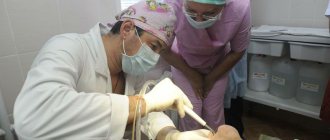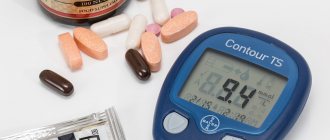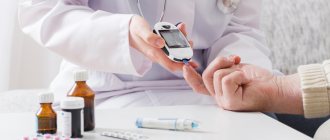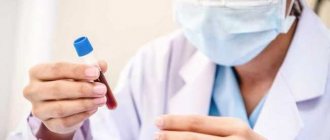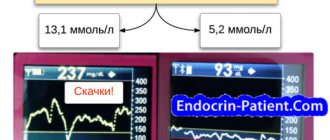Type 2 diabetes mellitus (abbreviation: T2DM) is a metabolic disease characterized by chronic hyperglycemia caused by impaired cell sensitivity to insulin or its deficiency. In the article we will analyze vascular drugs for type 2 diabetes mellitus.
T2DM
Attention! In the International Classification of Diseases, 10th revision (ICD-10), diabetes with peripheral circulatory disorders is designated by code M10.5.
Prevention of vascular damage
To reduce the risk of damage to blood vessels, patients with diabetes need to adhere to the following preventive measures:
Strictly follow all doctor’s instructions and do not self-medicate
If you experience discomfort in your limbs or deterioration in your health, it is important to notify your doctor in a timely manner. This will help to recognize the problem in time and begin its treatment. Follow a special diet, do not provoke an increase in blood sugar levels
To do this, exclude all sweet foods and low-carb foods from the diet. Preference is given to certain varieties of fresh vegetables and fruits, herbs, and lean meat. Lead a healthy lifestyle. It is important to give up bad habits and spend as much time in the fresh air as possible to prevent stagnation in the body. After consulting with your doctor, you can engage in light sports aimed at improving your well-being. This could be yoga or Pilates, leisurely walking, swimming. If the vessels are damaged, treatment begins as soon as possible to slow down the process of destruction and maintain them in good condition. It is necessary to carefully examine the lower limbs daily so as not to miss the occurrence of trophic ulcers. If the skin is prone to dryness, it is treated with softening and moisturizing creams that increase elasticity.
Diabetes mellitus is an insidious disease that first of all affects the blood vessels, thereby causing disturbances in the functioning of all internal organs. To avoid complications, you need to carefully monitor your own well-being and carefully follow all the instructions of your doctor.
X
Feet care
To prevent dire consequences, you must follow the rules for caring for the lower extremities:
- monitor the condition of your feet and regularly inspect your feet.
- wash your feet as often as possible;
- get rid of calluses and corns immediately after they appear;
- trim your nails carefully, without cutting to the very root;
- do not walk barefoot;
- do not forget about preventive measures to prevent fungal infections;
- eliminate all bad habits;
- buy suitable shoes, carefully choosing the size;
- purchase special insoles designed for diabetics.
By adhering to these rules, it is easier to avoid the serious consequences of diabetes.
Preventive measures
You should not think that if you have diabetes in your body, you can avoid complications and other disturbances in the functionality of organs and systems. This is simply impossible.
The situation can be corrected only through careful monitoring of the state of the body.
If you follow the recommendations of doctors regarding the prevention of cardiovascular diseases and vascular damage, you can delay the occurrence of serious malfunctions in the body’s systems.
It is important to carefully observe how the large arteries located at the inner ankle, on the thigh, wrist and in the area under the knees pulsate. You also need to monitor the duration of walking so that it is not accompanied by painful sensations during the process.
If a person notices a change in the shade of the skin, hair loss on the legs, or the formation of ulcers, then you need to immediately visit a specialist who will help you quickly understand the situation. The patient will also notice changes in sensitivity and other atypical sensations.
After visiting a medical facility, the doctor will refer the patient for a detailed examination of the condition of the blood vessels (ultrasound examination of the heart, coronary angiography, angiography of the lower extremities, kidneys and other organs).
Once it has been noted that a person's blood vessels have been seriously damaged, they will be prescribed appropriate medications to stabilize their health.
There is no universal cure for the treatment of blood vessels in type 2 diabetes mellitus. The range of measures to eliminate diseases affecting blood vessels is very extensive.
Complex therapy includes the following activities:
balanced diet. She should completely avoid eating foods containing large amounts of fat and sugar. The most suitable diet should only be prescribed by the attending physician; taking special pharmacological agents. They are necessary to control glucose levels in the body. Vascular drugs for type 2 diabetes mellitus: angiotensin-converting enzyme inhibitors, beta blockers, calcium channel blockers and diuretics; treatment of retinopathy. If a person suffers from this disease, urgent surgical intervention using a laser is necessary. During this process, this instrument removes damaged vessels that were damaged during the development of diabetes mellitus.
It is important to note that this disease can affect the quality of vision; treatment of a disease that affects the peripheral arteries of the lower extremities. If ulcers occur on the legs, it is necessary to carry out special therapy using antibiotic drugs that can prevent further infection and the appearance of new formations
If not treated in a timely manner, these ulcers increase in volume even more and become infected, resulting in the death of an impressive amount of tissue. Next, gangrene of the limb develops, which leads to inevitable amputation of the leg. In order to restore impaired blood circulation in it and avoid amputation, it is necessary to perform angioplasty, stenting, endarterectomy or bypass surgery.
To avoid the destruction of blood vessels in diabetes, you need to clean them regularly. To do this, use a decoction of bay leaves for several days.
You can prepare a decoction for cleaning vessels as follows: pour 5 g of bay leaf into one glass of boiling water and put on low heat.
Cook the mixture for five minutes, then remove from heat. Pour the resulting liquid into a thermos and leave for four hours. Before use, it must be thoroughly strained to remove fragments of leaves and twigs of the plant.
You should not drink the entire decoction at once, as this may cause bleeding. The drink must be carefully divided into several small portions, which must be drunk within six hours.
After this, you need to do an enema to prevent allergic reactions. Vessel cleaning for diabetes is carried out for 3 days, then you need to take a break for a week. After seven days have passed, you can again continue cleansing the body with this useful and healing mixture.
Lifestyle
If a person with diseased blood vessels due to diabetes reconsiders his lifestyle, then there is a high probability of improvement in the condition of the whole organism.
The set of measures that is aimed at radically changing the current way of life is as follows:
Stages of development of diabetes complications on the feet
There are 3 degrees of peripheral blood flow impairment in patients with diabetes mellitus.
1st degree - no symptoms or signs of disease of the blood vessels of the legs:
Diabetes mellitus is a serious disease; in the presence of such a diagnosis, a person must be especially attentive to his health and prevent the condition from worsening. There are many manifestations of diabetes; very often the blood vessels of patients suffer.
In diabetes, blood vessels are destroyed much faster than in other autoimmune diseases. Atherosclerosis and similar disorders associated with the failure of metabolic processes within the human body are diseases that accompany diabetes.
To prevent complications, doctors strongly recommend cleaning blood vessels; this procedure is considered the best way to combat atherosclerotic disorders. Thus, in diabetics it is possible to prevent stroke, heart attack, and gangrene.
Why itching occurs in diabetes mellitus and how to treat it
Itching in diabetes is not the most dangerous, but one of the most unpleasant symptoms of diabetes. Unfortunately, it is also a fairly common manifestation. Diabetic skin itching can become unbearable and significantly reduce the patient's quality of life. This makes it impossible to concentrate on work, let alone your personal life. Itching in diabetes mellitus must be treated - this will not only make the life of a diabetic easier, but also protect against complications.
Why does the skin start to itch?
Itching in diabetes affects mainly the lower extremities, but can spread throughout the body. The patient suffers greatly from such attacks, especially if the burning sensation began in a public place, when communicating with colleagues or other strangers. It would be indecent to itch, and even dangerous, because wounds on the skin with such a diagnosis heal very poorly and slowly, and also tend to fester.
OUR READERS RECOMMEND!
Our readers successfully use DiabeNot to treat joints. Seeing how popular this product is, we decided to bring it to your attention.
Itching of the skin in diabetes is explained by the same reasons as the occurrence of the pathology itself. Diabetes mellitus develops due to disorders of carbohydrate and lipid metabolism. The pancreas does not produce or produces too little insulin, causing glucose and some toxic substances to accumulate in the blood.
This affects the functioning of other human organs, in particular the condition of his hair, nails and skin.
The following symptoms are noted:
- nails become brittle, grooves and spots appear on the nail plate;
- the skin loses elasticity and acquires an unhealthy color;
- hair becomes dull and falls out rapidly.
The skin becomes very sensitive, it is easily irritated, and is prone to the development of a variety of pathologies. Neurodermatitis is one of them. At the same time, symptoms of neurodermatitis may appear even before diabetes mellitus itself is diagnosed.
Also, the cause of itching in patients suffering from diabetes mellitus may be a simple allergic reaction to a large number of constantly taken medications. With such a disease, it is very rarely possible to limit yourself to just one medication or to do without them altogether. Usually you have to take two or three different drugs with different effects several times a day. This leads to an allergic reaction, which is manifested (primarily) by burning and itching of the skin. Often a rash, red, yellow or pale spots are visible on it.
How to help a patient
Treatment is as follows:
Dieting. Nutrition in diabetes plays a key role. Under no circumstances should you consume sweets and confectionery products, which can cause an exacerbation of the disease and its symptoms.
You should also be careful when eating foods that are potential allergens - citrus fruits, grapes, strawberries, tropical fruits, beets, tomatoes. Avoid fatty foods flavored with spices, everything spicy and salty.
Use of medications. If your skin is very itchy, you should definitely tell your doctor. After examination, he will select the optimal ointment. As a rule, products are used that relieve itching and swelling, moisturize and soften the skin. These are Flucinar and Dermazol - drugs that contain corticosteroids. If the need arises, creams and ointments with an antifungal or antibacterial effect are prescribed.
Only a doctor can select the correct treatment regimen and medications.
Is it possible to use folk remedies?
If the skin is very itchy, blisters form, or a rash appears, lotions and compresses based on decoctions of medicinal plants quickly alleviate the patient’s condition.
You can make baths and baths with a healing effect from the same products.
Traditional medicine for various dermatitis, eczema and other skin diseases accompanied by severe itching recommends using plants that have an antiseptic, decongestant and wound-healing effect:
- celandine;
- sequence;
- chamomile;
- oak bark;
- sage.
It is important after a bath not to rub the skin with a towel, but to blot it dry. After this procedure, a medicinal ointment is applied strictly to dry skin.
It will be useful to use decoctions of medicinal plants not only externally, but also taken internally.
The same series, nettle perfectly cleanses the blood, improves its composition, and helps cope with rashes and swelling of the skin.
If you follow all doctor's prescriptions and proper care, itching will be very rare and will not lead to the development of skin complications.
Foot diseases, main symptoms
Leg disease in people with diabetes manifests itself with different symptoms and appears due to certain reasons. The most common is diabetic foot syndrome (diabetic neuropathy).
- Diabetic neuropathy is when the peripheral nervous system, due to large amounts of glucose, stops transmitting nerve impulses, cells die, and the person stops feeling anything. As a result of this disease, ulcers may appear on the legs, which take quite a long time to heal. With this disease, the patient completely ceases to feel any pain. It is very important to consult a doctor, since the wounds that appear may not heal, bacteria will begin to develop in them, as a result of which the limb may simply be amputated.
- Problems with peripheral arteries, which manifest themselves in the fact that the patency of the blood vessels decreases, the tissues of the legs stop receiving oxygen, which causes pain in the patient. Starving the tissues of the lower extremities can also lead to amputation, so at the first sensation of pain or cramps you should consult a doctor.
- Swelling of the lower extremities. Appear due to nephrotic syndrome or atherosclerosis. To reduce swelling, the patient needs to balance the diet and monitor physical activity.
- Leg ulcers. They appear when tissue is damaged, due to neuropathy or vascular pathology. Ulcers are formed as a result of calluses, burns, cracks, and bruises. If there is the slightest hint of the formation of an ulcer, you should consult a doctor to prevent the appearance of pus.
There are 3 stages of ulcer formation:
- Previous (fever, swelling, pain in the lower leg, tooth).
- Expanded (skin defects appear, bloody spots appear, the volume of the wound increases).
- Progressive (a purulent ulcer appears, body weakness, temperature, and pain increase).
The use of droppers in the treatment of neuro- and angiopathy
Intravenous administration of drugs can also be carried out during the planned treatment of patients with diabetes. For this purpose, drugs are used that act directly on the vascular wall, improving microcirculation and metabolic processes in tissues.
The most common group of drugs for the treatment of patients with diabetes is thioctic acid. These are medications with proven clinical effectiveness for polyneuropathy.
Lipoic acid for diabetes and its preparations regulate metabolic processes involving carbohydrates and fats, improve cholesterol levels in the blood, reduce the formation of free radicals and lipid peroxidation in nerve fibers.
Thioctic acid preparations - Thiogamma, Espa Lipon, Thioctacid, Dialipon, Berlition improve blood supply and conductivity in the nervous system, and also help the skeletal muscles use glucose without the participation of insulin.
Indications for the use of drugs for diabetes mellitus:
- Diabetic polyneuropathy.
- Micro- and macroangiopathy.
- Chronic hepatitis.
- Hyperlipidemia and atherosclerosis.
The use of drugs begins with intravenous administration, prescribing 600 mg per day; for severe polyneuropathy and signs of diabetic foot, the dose can be increased to 900 - 1200 mg. Droppers are placed for 10 to 20 days, and then they switch to taking 600 mg of the drug in tablets 1 to 3 times a day.
The course of treatment with thioctic acid drugs lasts from one to three months. Prophylactic use of drugs can be recommended in doses half as low as for therapeutic use.
The use of intravenous administration of Mexidol in a complex of therapeutic measures for diabetes helps to reduce the dose of drugs to correct hyperglycemia, avoid complications of diabetes mellitus and achieve compensation for the disease in a labile course of the disease. Mexidol is indicated for patients with impaired lipid metabolism, as well as for the following pathologies:
- Severe diabetic neuropathy.
- Retinopathy.
- Nephropathies with manifestations of renal failure.
- Dyscirculatory or diabetic encephalopathy.
- Memory impairment, intellectual disability.
The course of treatment can be carried out over 5-7 days using 200 mg of Mexidol per 100 ml of saline solution. The dose is selected based on the biochemical parameters of carbohydrate and lipid metabolism.
In the treatment of diabetes, droppers with vascular drugs such as Actovegin, Wessel Due F, Mildronate, Trental can be prescribed. Vitamin, antihypertensive and vasodilator drugs are also used in various combinations. The video in this article will tell you how diabetes is treated with infusion therapy.
Sugar level
Man
Woman
Enter your sugar or select your gender to get recommendations
Please indicate the man's age
Please indicate the woman's age
Latest discussions:
Causes of diabetic vascular damage
It is a proven fact that the more time a person suffers from diabetes, the higher the risk of vascular damage. The increased risk of vascular disease in diabetes is directly related to high blood pressure , non-compliance with a strict diet , smoking, and lack of sufficient physical activity. , atherosclerosis occurs more often as a consequence of the accumulation of cholesterol . cholesterol plaques form , which prevent the free transport of oxygen to the heart muscle. If a cholesterol plaque breaks off, a blood clot , which subsequently becomes the cause of serious diseases - stroke , gangrene , as a consequence of insufficient blood circulation in the extremities.
Preparations and methods of treating legs for diabetes mellitus
Diabetes mellitus causes negative changes in various organs, disrupting their integrity and functions. It causes complications on the legs and causes the development of diabetic foot syndrome.
Every diabetic needs to be aware of the possible consequences of the disease and take preventive measures.
The more experience a diabetic has, the higher the likelihood of pathology occurring. Thus, when the disease lasts more than 20 years, approximately 80% of patients develop leg diseases and other serious consequences of diabetes.
The main way to prevent leg disease in diabetes is to control and maintain normal glucose levels.
Foot diseases in diabetics
Diabetic neuropathy is a pathology associated with disruption of the nervous system in the patient’s body. With it, tissue sensitivity worsens, i.e. a diabetic reports feeling pain and temperature, especially in the lower extremities.
Diabetic foot – occurs in at least 10% of all people with diabetes. This name refers to a whole range of complications associated with the deterioration of the legs and feet of a diabetic, in particular.
Vascular angiopathy of the lower extremities is another consequence of the disease, which is characterized by negative changes in blood vessels and arteries. There are 2 types of it - microangiopathy and macroangiopathy.
Beginning problems with blood vessels are signs of diabetes in the feet; this is a good reason to contact a diabetic foot office for qualified medical help.
Leg cramps are a common complaint in patients with long-term diabetes. Appear due to high blood sugar and increased urination. Since all the microelements and beneficial substances necessary for the body are excreted along with urine, the tissues experience a lack of nutrition, which causes convulsions.
Foot treatment methods
Many patients are recommended to use a special medicinal ointment for their feet for diabetes. It should have a moisturizing effect and include urea.
Therapeutic ointments "Diaultraderm", "Diaultraderm Aqua" and "Diaultraderm Silver" are suitable. They should not be used for self-massage and should not be used without prior permission from a doctor.
Effective ointments and creams for feet for diabetes:
- For dry skin - DiaDerm softening cream (available for hands and feet).
- For calluses - DiaDerm Intensive cream, 10%
- For the prevention of fungus - DiaDerm Protective ointment
- For the treatment of fungal diseases - ointments based on zinc oxide
- For skin diaper rash - DiaDerm talc
For cracks in the feet, it is useful to use non-greasy balms based on natural propolis. But you shouldn’t apply regular fatty and nourishing foot cream for diabetics.
A balanced diet for a type 2 diabetic, a low-carbohydrate diet for type 1 disease, and moderate exercise can significantly improve the condition of the patient’s legs and general well-being. exercise and normalization of blood sugar levels - an article about this.
Massage is a treatment for diabetic feet that reduces pain and increases sensitivity. But for severe pain, it will not help; in this case, it will be more effective to use painkillers for diabetic foot.
You can start a foot massage only if you know the basic rules for carrying it out, so we advise you to first watch the training video.
If there are trophic ulcers on the limbs or the first signs of gangrene, you cannot start foot massage with diabetes.
Daily hygiene and proper foot care play an important role in treatment. Shoes should be comfortable, preferably orthopedic.
The patient is recommended to examine his feet and the skin of his lower extremities every day for injuries, wounds and scratches. If they are detected, careful treatment and consultation with a doctor are required, because with diabetes, even minor skin injuries can cause the development of a non-healing ulcer with serious consequences.
The mechanism of vascular problems in diabetes
During diabetes, there is a complex deterioration in the physiological functions of the body.
Regarding blood vessels, medical science distinguishes 2 types of vascular lesions - microangiopathy and macroangiopathy. With hyperglycemia, an interaction between proteins and sugar occurs, which is called protein glycation; due to hemodynamic disturbances, cell functions and blood fluidity (rheological properties of blood) are disrupted.
Lipids are deposited on the walls of arteries and veins, platelets stick together, and atherosclerotic plaques form. In diabetes mellitus, blood vessels become fragile and brittle, hypoxia and irreversible damage develop in the tissues.
How to dilate blood vessels for normal functioning of the whole body
Nowadays, there are a huge number of medications that can be used to dilate blood vessels. But before using any drug, you should consult your doctor. The most common of them are spasmalgon, papaverine, nitroglycerin and many others.
They relieve spasms and promote dilation of blood vessels not only in the head, but also in the entire body as a whole, which significantly facilitates the patient’s well-being.
How to dilate blood vessels at home
If you don’t have time to see a doctor, you can dilate blood vessels at home:
- Garlic is an excellent remedy for expanding the vascular system. Just chop a clove of garlic, add a glass of vegetable oil, and let it brew in the refrigerator for 1 day. Drink 1 teaspoon 3 times a day.
- Hawthorn – is able to relieve spasms and has a strengthening effect on blood vessels. 30 grams of hawthorn fruits are poured into 200 grams. boiling water Cook for 5 minutes over low heat. Then you should strain, cool and take 30 minutes before meals. There is another way. Add 20 drops of hawthorn tincture to half a glass of boiled water. Drink 20 minutes before meals.
Dilating herbs such as chamomile, valerian, lemon balm, linden tea, clover flowers, mint, and dandelion root also help. With their help, you can not only dilate blood vessels, they will also cleanse the circulatory system of accumulated cholesterol.
Cleaning vessels with pine cones
The pine cone has many healing properties. Essential oils, vitamins, bioflavonoids, but its main and valuable component is pycnagenol, due to which vasodilation occurs and the death of brain cells is blocked. This is why tinctures are made from pine cones.
Tincture made from pine cones has an antibacterial and preventive effect on the cardiovascular system. But despite the fact that pine cones are very useful, they also have contraindications:
- pregnancy and breastfeeding,
- liver and kidney disease,
- alcoholism,
- people suffering from allergies.
There are many tinctures made from pine cones, thanks to which they heal the body and strengthen blood vessels:
Tincture of young green cones
- Chopped pine cones – 500 gr.
- Vodka – 2.5 l.
Grind the main ingredient, pour into a three-liter jar, add vodka. Next, you need to take it to a dark place for 14 days. After a while, the tincture should be strained. Take the drink 30 minutes before your main meal, 1 tablespoon three times a day.
Red cone tincture
- Red cones – 20 pcs.
- Vodka – 1 l.
The main ingredient should be placed in a wide-necked jar. Add vodka to it, then take it to a dark place for 14 days. After the time has elapsed, strain with gauze and pour 1 teaspoon of apple cider vinegar into the tincture. The drink should be taken 1 teaspoon after the main meal, write 2 times a day. The entire course of treatment lasts 6 months.
Tincture of cones on water
- Green cones – 15 pcs.
- Water – 1 liter.
- Sugar – 1 kg.
Chop the cones, add water and cook over low heat. Add sugar. Cook for 2 hours, stirring and skimming. When the syrup is ready, it will turn red. Cool and strain. Take 1 tbsp on an empty stomach. spoon 4 times a day. This tincture helps to recover after a stroke.
It is necessary to monitor your health, because a disease detected in time is easier to treat, which leads to a speedy recovery.
Diagnostic measures
Diagnosis should be carried out as early as possible, because in this case it will be possible to avoid the development of complications.
The patient will need to specifically examine the condition of the lower extremities. Specially trained endocrinologists, as well as vascular surgeons and nurses can help with this. It is strongly recommended to pay attention to the following:
- doctors identify the degree of damage to the lower extremities, adjust the treatment of the underlying disease and prescribe specific therapy for neuro- and angiopathy;
- nurses teach patients proper foot care and perform hygienic treatment of feet. For example, calluses are cut off or medicated creams, ointments and other compounds are used;
- It is necessary to undergo examination both at the initial diagnosis of diabetes mellitus and in the future at least once every 12 months if you are feeling optimally.
The studies that are carried out in the office if your toes hurt are primarily an examination with mandatory monitoring of the pulse in the lower extremities
In addition, an important part of the diagnosis is the control of neurological reflexes and ultrasound of the blood vessels of the legs. It is recommended to test pain, tactile, temperature and vibration sensitivity, electroneuromyography
Diagnostics
To diagnose cardiovascular diseases, biological samples are taken - blood, urine, and the organs that take the brunt of vascular pathologies are examined - the heart, kidneys, brain, retina. Diagnostics includes the following methods:
- Assessment of the excretory capacity of the kidneys (glomerular filtration rate).
- ECG and EchoCG.
- Blood lipid spectrum, which determines deviations in the body's fat metabolism.
- Ophthalmological examination.
- Coronary angiography is an examination of the coronary arteries. Coronary angiography is done only with the consent of the patient.
- Dopplerography of the kidneys and extremities is a study of blood flow in large and medium-sized arteries.
- Arteriography, in which the condition of blood vessels is determined using a contrast agent and x-ray radiation.
- Ultrasound of the kidneys.
- Brain MRI.
Complications
For most patients, leg swelling does not cause much discomfort. But if left untreated, complications develop. Pain and burning appear in the limbs. The skin becomes thinner, becomes dry, brittle, and easily injured. Wounds that heal slowly become infected.
Blood clots form in the deep veins of the extremities. Thrombosis is a serious complication, recognized by the following symptoms:
- uneven swelling (limbs differ in size);
- swelling does not go away at night, by morning the leg acquires a pathological size;
- the patient experiences pain while standing;
- the skin turns red;
- discomfort is felt in the limbs.
In case of thrombosis, massage is prohibited . The rupture of a blood clot leads to a life-threatening condition. Pulmonary embolism develops - a pathology that can result in death.
Diabetic angiopathy of the lower extremities
Diabetic angiopathy refers to lesions of large (macroangiopathy) and small (microangiopathy) vessels that occur in patients with diabetes mellitus. More often, the process involves the brain, visual analyzer, urinary system, heart, and vessels of the lower extremities.
Features of the disease
The development of damage to the circulatory system against the background of diabetes mellitus is accompanied by:
- compaction of vascular walls;
- lipid and cholesterol deposits on the endothelium;
- thrombus formation;
- decrease in vascular lumen;
- formation of swelling and increased exudation;
- disruption of the trophism of cells and tissues up to their death.
Since capillaries have the smallest lumen among all arterial-type vessels, they suffer first. This means that the process of damage begins with the toes, feet, then moves to the legs and reaches the thighs.
Clinical picture
Symptoms of diabetic angiopathy of the lower extremities depend on the course of the pathological process:
- Stage I – there are no visual changes, the patient has no complaints, instrumental and laboratory examinations show the development of an atherosclerotic process in the vessels;
- Stage II - the appearance of the so-called intermittent claudication - a specific symptom that is characterized by the need to stop while walking due to severe pain in the legs, which disappears during rest;
- Stage III – pain syndrome appears even in the absence of load on the legs, requiring constant change of position in bed;
- Stage IV - the formation of painless ulcers and dead areas on the skin due to serious disturbances in the trophism of tissues and cells.
Accompanying symptoms characteristic of damage to the blood vessels of the legs in diabetes mellitus:
- feeling of burning, tingling, “goosebumps”;
- formation of spider veins;
- pale skin;
- dry skin, peeling, hair loss;
- brittle toenails;
- development of swelling.
Diabetic foot
One of the most severe complications of leg vascular angiopathy. It can develop in insulin-dependent and non-insulin-dependent types of the disease. It manifests itself as purulent-necrotic processes, the formation of ulcers, and damage to bone and tendon structures. The process involves the innervation system, muscular system, and deep tissues.
Diabetic foot symptoms:
- wounds, ulcerations on the legs due to diabetes mellitus;
- thickening of the nail plates;
- fungal infection on the feet;
- itching;
- pain syndrome;
- lameness or other difficulties encountered while walking;
- change in skin color;
- swelling;
- the appearance of numbness;
- hyperthermia.
Diagnostics
With such problems, you can contact an angiosurgeon or endocrinologist. After examination and collection of complaints, the doctor prescribes laboratory, instrumental and hardware assessment of the following indicators:
- biochemical screening – glucose, creatinine, urea levels, blood clotting status;
- ECG, echo CG at rest and with exercise;
- X-ray examination;
- arteriography of the lower extremities - assessment of patency using a contrast agent;
- Dopplerography - ultrasound examination of the condition of blood vessels;
- in the presence of purulent discharge from an ulcer - bacteriological examination with an antibiogram;
- determination of transcutaneous tension - assessment of oxygen levels in the tissues of the extremities;
- computer capillaroscopy.
Features of treatment
The basis of therapy is to maintain blood sugar levels within acceptable limits. The insulin-dependent type of diabetes mellitus requires injections of the pancreatic hormone (insulin) in accordance with a regimen developed by an endocrinologist. It is necessary to observe the injection time, dosage, and conduct self-monitoring using a glucometer.
For type 2 diabetes, hypoglycemic drugs are used:
- Metformin - helps improve the sensitivity of body cells to insulin, increasing the absorption of sugar by tissues. Analogs - Glycon, Siofor.
- Miglitol - inhibits the ability of intestinal enzymes to break down carbohydrates into monosaccharides. The result is no increase in sugar levels. Analog – Diastabol.
- Glibenclamide (Maninil) – promotes the activation of insulin synthesis.
- Amaryl - stimulates the production of a hormonally active substance, which helps reduce the amount of sugar.
- Diabeton - the drug enhances the production of insulin, improves the rheological properties of blood.
Cholesterol-lowering agents
The drugs can be used both as part of therapy and to prevent the development of diabetic angiopathy of the lower extremities. Medicines should be taken with laboratory tests of biochemical blood parameters over time.
| Drug name | Active substance | Features of the action |
| Aterostat | Simvastatin | Reduces cholesterol and lipoprotein levels, contraindicated in renal failure, children, pregnant women |
| Zokor | Simvastatin | Normalizes the amount of triglycerides and total cholesterol levels. Take with caution in cases of liver or kidney pathology, increased levels of transaminases in the blood serum, or alcoholism. |
| Cardiostatin | Lovastatin | Reduces the liver's ability to form cholesterol, thus controlling its level in the blood |
| Lovasterol | Lovastatin | Analog of Cardiostatin. Not used during pregnancy, breastfeeding, severe renal failure |
| Liptonorm | Atorvastatin | Increases the protective mechanisms of the vascular wall, inactivates the process of cholesterol formation |
Antihypertensive drugs
Against the background of a decrease in blood pressure, vasodilation occurs, an antiarrhythmic effect. Blood circulation improves slightly. Products used:
- Nifedipine,
- Corinfar,
- Kordipin,
- Equator,
- Binelol,
- Nebilet.
The mechanism of vasodilation is based on the fact that receptors located in the walls of the arteries and heart are blocked. Some of the drugs can restore heart rhythm.
Angioprotectors
The action of this group of medications is aimed at improving blood supply to the tissues and cells of the body, as well as increasing the resistance of the walls of blood vessels.
- Pentoxifylline (Trental) - the drug helps to dilate blood vessels, improve blood supply, and increase the action of the protective mechanisms of the endothelium.
- Troxevasin – prevents lipid oxidation, has an anti-exudative effect, and stops the development of inflammatory processes.
- Niacin - by dilating blood vessels, the drug helps reduce total cholesterol levels.
- Bilobil - normalizes the permeability of vascular walls, participates in the restoration of metabolic processes.
Antiplatelet agents
The drugs block the biochemical processes of thrombus formation, preventing blockage of the vascular lumen. The following representatives showed effectiveness:
- Aspirin,
- ReoPro,
- Tirofiban,
- Chime,
- Dipyridamole,
- Plavix.
Enzymes and vitamins
The drugs restore metabolic processes, participate in the normalization of the permeability of vascular walls, have an antioxidant effect, increase the level of glucose use by cells and tissues, thereby contributing to the process of its reduction in the blood. Solcoseryl, ATP, B vitamins, Ascorbic acid, Pyridoxine are used.
Surgery
To restore the patency of an artery or a certain segment of it, revascularization operations are performed.
Bypass surgery is the sewing in of a vascular implant as a bypass to restore blood circulation if it is impossible to expand the lumen of the vessel. There are aorto-femoral, femoral-popliteal and iliofemoral bypass surgery depending on which area the shunt is sewn into.
Profundoplasty is an operation to replace a section of an artery closed by atherosclerosis with a patch made of synthetic material. Combined with endarterectomy.
Lumbar sympathectomy - removal of the lumbar ganglia that cause vasospasm. With their excision, the vessels dilate, improving blood flow in the affected area of the arteries. Often combined with profundoplasty or bypass surgery.
Revascularizing osteotrepanation – perforations are made in the bone tissue to activate collateral blood flow.
Balloon angioplasty is the introduction of special devices (balloons) into the lumen of the affected artery to enlarge it by inflating it.
Stenting is performed similarly to balloon angioplasty, only a stent remains in the lumen of the vessel. This device prevents the artery from narrowing and traps thrombotic masses.
In advanced stages of the disease, amputation may be necessary to save the patient's life. The doctor determines the height of the intervention based on the level of presence of “living” tissue. Timely initiation of therapy will reduce the risk of complications and return the patient to an optimal level of health.
Examinations and consultations
When complaining of pain in the legs, the patient is consulted by doctors of the following specialties:
- therapist,
- endocrinologist,
- neurologist,
- ophthalmologist (fundus condition),
- surgeon.
List of necessary laboratory tests
- glycemic profile, level of glycosylated hemoglobin;
- lipid profile of blood plasma.
Instrumental research methods
- ultrasound examination of the arteries of the lower extremities with Doppler sonography;
- X-ray examination of the feet.
Traditional methods
It is necessary to understand that such methods of therapy are additional, and their use must be agreed with a specialist. One of the most commonly used remedies is a decoction based on flaxseeds. To prepare it, it is recommended to use two tbsp. l. seeds, which are poured into 500 ml of boiling water and boiled for 15–20 minutes over low heat. Then the broth must be allowed to brew at room temperature for two hours and carefully filtered. It is recommended to consume the decoction for five days, twice a day, a quarter cup.
A special cream may be effective for leg pain due to diabetes. It is made from nettle root and vegetable oil. The preparation algorithm is as follows: bring 150 ml of any vegetable oil to a boil, then add chopped nettle root and boil for 15 minutes. After this, the cream is cooled and applied to problem areas.
